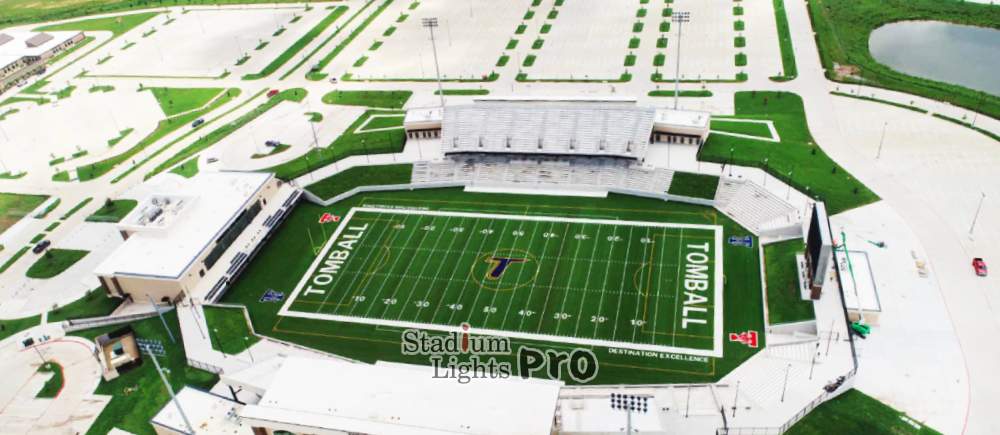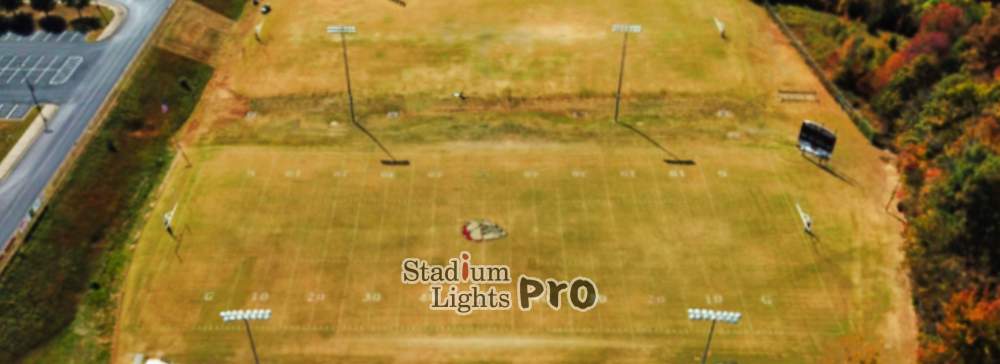Table of Contents
ToggleTypes of Grants and Financial Aid
Federal Grants
Federal grants are a substantial source of funding for upgrading football field lighting systems. These grants are particularly valuable because they are often specifically tailored to support infrastructure and energy efficiency projects.
Energy Efficiency and Conservation Block Grant Program
Administered by the U.S. Department of Energy, this program promotes energy-saving initiatives across various sectors, including public infrastructure projects like sports facilities. Grants typically range from $50,000 to $500,000, depending on the project’s scope and scale. Applicants must meet specific eligibility criteria, demonstrating the project’s potential to reduce energy consumption and enhance environmental sustainability. The application process requires a detailed project proposal outlining goals, expected outcomes, and a comprehensive budget. Additionally, applicants must adhere to federal regulations, public hearings, and environmental reviews to ensure only impactful projects receive funding.
Community Development Block Grants (CDBG)
Administered by the U.S. Department of Housing and Urban Development (HUD), CDBG funds support projects benefiting low- and moderate-income communities, including recreational facility upgrades. Grant amounts generally range from $20,000 to $200,000. To apply, organizations must show how their project addresses community needs, improves quality of life, and fosters economic development. The application process involves submitting a detailed proposal with a project description, expected benefits, and budget. Evidence of community support and alignment with CDBG priorities is also required.

State and Local Grants
State and local governments offer various grant opportunities that can be instrumental in securing funding for football field lighting projects. These grants often focus on enhancing local infrastructure, improving recreational facilities, and supporting community development.
Statewide Park Development and Community Revitalization Program (California)
This program provides significant funding for upgrading parks and recreational facilities, including sports lighting systems. Grants can range from $200,000 to $8 million, reflecting the program’s commitment to supporting large-scale and impactful projects. The application process involves submitting a detailed proposal outlining project goals, benefits, and a comprehensive budget. Applicants must also demonstrate how the project aligns with state priorities for park development and community revitalization.
Local Municipal Grants
Local municipalities, such as the City of Dallas, offer grants up to $100,000 for park improvements, including lighting upgrades. These grants are designed to support projects with a direct positive impact on the community. Applicants need to demonstrate the project’s alignment with local development goals, provide evidence of community support, and detail how the project will enhance residents’ quality of life. The application process typically involves submitting a proposal highlighting the project’s benefits, community impact, and alignment with local priorities.
Private and Non-Profit Organizations
Private and non-profit organizations play a crucial role in supporting community sports facilities through grants and donations. These organizations often focus on community well-being, youth development, and health promotion.
Robert Wood Johnson Foundation
Offering grants ranging from $50,000 to $500,000, this foundation supports projects that promote community health and well-being, including sports facility upgrades. The foundation is committed to improving public health and strengthening communities. Applicants must submit a proposal demonstrating alignment with the foundation’s mission, project benefits, and adherence to funding criteria.
Sports and Youth Foundation
Providing grants between $10,000 and $100,000, this foundation supports projects enhancing sports infrastructure, including lighting upgrades for football fields. The application process involves detailing how the project aligns with the foundation’s mission, benefits the community, and meets funding criteria. Crafting a compelling proposal is crucial to increase the chances of securing funding.
Corporate Sponsorships
Corporate sponsorships offer a valuable opportunity for obtaining financial support for football field lighting projects. Many companies view sponsorships as a way to enhance their corporate social responsibility (CSR) profiles while contributing to community development.
Leading companies like Nike and Adidas have a history of sponsoring sports facilities and events, providing funding that can range from $25,000 to over $1 million. These sponsorships offer essential funding and significant brand visibility and positive public relations.

Eligibility Criteria
General Eligibility Requirements
Eligibility for grants and financial aid hinges on various factors including the nature and scope of the project, its potential community impact, and the status of the applicant. For federal and state grants, projects typically need to address public or low-income community needs and adhere to specific guidelines detailed in the grant’s criteria. Generally, applicants must be non-profit organizations, municipalities, or educational institutions. Federal grants often have stringent requirements including comprehensive documentation, such as financial statements and detailed project plans, to ensure that the funds are used effectively. For state and local grants, the focus might be on how well the project aligns with regional development goals or local priorities.
Private and non-profit grants, on the other hand, may have different eligibility criteria, which often include alignment with the funder’s mission and a demonstrated potential for significant community benefit. These grants might prioritize projects that resonate with their charitable objectives and show promise in creating tangible, positive outcomes in the community.
Specific Criteria
Each funding source comes with its own set of specific criteria. Federal grants are usually accompanied by rigorous documentation requirements. This often includes a detailed description of the project, financial projections, and evidence of the project’s potential impact. State and local grants might place a higher priority on projects that support local economic development or address specific regional issues.
Private foundations and non-profit organizations might focus their criteria on how closely a project aligns with their mission or specific funding priorities. For instance, a private grant might support projects in arts and culture, education, or health, depending on the foundation’s focus. Corporate sponsors are often drawn to projects that offer high visibility and demonstrate strong community engagement, aligning with their branding and corporate social responsibility goals.
How to Determine Eligibility
Determining if your project qualifies for funding involves a careful review of each funding source’s eligibility requirements. Start by reading the guidelines provided by the funding agency or organization to understand their specific criteria. Check whether your project aligns with these requirements and ensure that you can provide the necessary documentation. Many grant agencies and organizations offer detailed eligibility guidelines on their websites, which can be an invaluable resource for assessing your project’s fit and preparing a compelling application.
If available, seek advice from grant writers or consultants who can help navigate the eligibility requirements and improve your chances of securing funding. By thoroughly understanding and aligning with the eligibility criteria of potential funders, you can enhance your project’s likelihood of receiving the necessary support.
Application Process
Preparing the Proposal
Project Description
A successful grant proposal starts with a thorough and engaging project description that outlines why your initiative deserves funding. Begin by clearly defining the project’s purpose, goals, and expected benefits. This section should present a compelling narrative that explains the need for the project and how it aligns with the priorities of the funding agency.
For instance, if you’re applying for a grant to upgrade the lighting at a community sports facility, detail how the new lighting system will enhance game visibility and ensure player safety. Specify the current issues with the existing lighting and how the proposed solution will address these problems. Articulate your objectives clearly, such as improving lighting conditions to reduce accidents and increase overall safety, as well as fostering greater community engagement by offering a better-quality facility for local events.
To strengthen this section, include data or anecdotes that illustrate the current problems and how the project will provide tangible benefits. For example, you might include testimonials from community members or statistics on current usage and incidents related to inadequate lighting.
Budget Breakdown
A comprehensive budget breakdown is crucial for demonstrating the feasibility of your project. This section should itemize all expected costs, providing a detailed financial overview that helps funders understand how their money will be used.
Start with a clear list of all expenses, such as $60,000 for purchasing new lighting equipment and $15,000 for installation services. Break down these costs further if possible, detailing specific items or services. For instance, list the types of lighting fixtures, their costs, and any additional materials needed. Also, include estimates for labor and any potential unforeseen expenses.
Ensure that your budget is realistic and aligned with the scope of the project. A well-organized budget not only shows that you have planned thoroughly but also builds trust with funders by demonstrating fiscal responsibility and transparency.
Expected Outcomes
In this section, outline the anticipated benefits of the project. Highlight how the project will positively impact the community, providing both quantitative and qualitative measures of success.
For example, you might project that the upgraded lighting will result in increased community use of the facility, with specific metrics such as higher attendance rates at events or more frequent bookings. Additionally, mention qualitative benefits like improved user satisfaction and enhanced safety during activities. Use data, such as surveys or usage statistics, to support your claims and provide a clearer picture of the project’s impact.
This part of the proposal should connect directly to the goals and objectives stated earlier, showing how the expected outcomes align with the project’s overall purpose and the funder’s interests.
Crafting the Narrative
Crafting a compelling narrative involves presenting your project’s needs and illustrating its potential impact in a way that resonates with the funder. Your proposal should not only describe what you need but also why it is essential and how it will make a difference.
Use evidence and data to back up your claims, including relevant research, statistics, or case studies. Ensure that your narrative is engaging and aligns with the funder’s priorities and interests. Tailor your language and approach to fit the specific guidelines and preferences of the funding agency.
A well-crafted narrative can significantly enhance your proposal’s effectiveness, helping you to stand out and making a strong case for why your project deserves support.

Documentation and Requirements
Common Documents
The grant application process typically requires a range of documentation to support your proposal. Key documents commonly requested include financial statements, detailed project plans, and letters of support. Financial statements should provide a comprehensive view of your organization’s financial health, including balance sheets, income statements, and cash flow statements. Detailed project plans should outline the project’s scope, milestones, and execution strategy, showing how the grant funds will be allocated and utilized throughout the project’s lifecycle.
Letters of support from community leaders, stakeholders, or partner organizations can enhance your application by demonstrating broad support for your project. These letters should clearly state how the supporters are involved with or impacted by the project and their reasons for endorsing it.
Preparing Documents
Gathering and preparing the required documentation demands careful attention to detail and accuracy. Financial statements must be up-to-date and accurately reflect the financial status of your organization. Ensure that the project plan includes clear milestones, timelines, and a detailed explanation of how each phase of the project will be executed. This plan should demonstrate how the project will progress from start to finish and how resources and risks will be managed.
Letters of support should be tailored to the specific project and funding opportunity, clearly stating the supporters’ involvement and endorsement. Consulting with financial and project management experts can be beneficial in ensuring these documents are prepared correctly. These professionals can provide valuable insights and assist in creating a realistic and comprehensive project plan.
Consulting Experts
Engaging with financial and project management experts can significantly enhance the quality of your grant proposal. These experts can help ensure that your financial statements and project plans are accurate and compliant with grant requirements. They can offer advice on creating a realistic budget and project plan, ensuring that all aspects of the proposal are well-supported and feasible. Their expertise can help improve the overall quality of your application, increasing your chances of securing the grant.
Submission and Deadlines
Deadlines
Meeting deadlines is a critical aspect of the grant application process. Each funding source will have specific deadlines for submission, which can vary widely. Federal grants often have annual deadlines, while state and local grants might follow different cycles or have rolling deadlines throughout the year. It is essential to be aware of these deadlines and plan your application timeline accordingly. Allow sufficient time for preparation, review, and submission to avoid last-minute issues and ensure that your application is submitted on time.
Submission Methods
Applications can typically be submitted through online portals or via physical mail. Many grant agencies provide dedicated online portals for application submission, which require adherence to specific formatting guidelines and attachment requirements. If the application must be submitted physically, ensure that all documents are correctly formatted, complete, and sent to the correct address. Following all submission instructions precisely is crucial to avoid any errors or delays in processing your application.
Tracking and Follow-Up
After submission, it is important to track the status of your application. Many grant agencies offer tracking systems or confirmation receipts that allow you to monitor your application’s progress. If necessary, follow up with the funding agency to confirm receipt of your application and address any additional requirements or questions. Being proactive in communication can help you stay informed about the review process and respond promptly to any requests for further information. Maintaining open communication with the funding agency can help ensure that your application is processed smoothly and efficiently.
Budgeting and Financial Planning
Creating a Realistic Budget
Detailed Cost Estimation
Start by detailing the costs of each component of the project. For instance, when upgrading the lighting for a football field, you need to account for various expenses. You might estimate around $70,000 for high-efficiency LED fixtures, which includes the cost of the equipment itself. Installation costs are another significant expense; budgeting approximately $20,000 for labor and installation services is advisable. Additionally, it is important to plan for ongoing maintenance, which might cost around $10,000 to ensure that the system remains operational and effective over time.
Contingency Fund
In addition to these specific costs, it is wise to include a contingency fund to address any unexpected expenses that might arise. Typically, this fund ranges from 5% to 10% of the total project cost. This contingency buffer helps manage unforeseen issues without disrupting the overall budget and allows for flexibility in case of changes or additional requirements.
Importance of a Detailed Budget
A detailed and realistic budget not only demonstrates to potential funders that you have carefully planned for every aspect of the project but also increases your chances of securing the necessary funding. It reflects thorough preparation and an understanding of the financial needs associated with successfully completing the project.
Allocating Funds
Establishing a Budget
The initial step in managing funds for a project is to establish a comprehensive budget. This budget should clearly outline all anticipated costs, helping to identify the most critical areas for expenditure. For example, in the context of a lighting upgrade project, the budget should allocate resources in a way that maximizes the effectiveness of the investment.
Effective Fund Allocation
Once the budget is set, the next step is to allocate funds effectively. This involves prioritizing spending on the most essential components to ensure that resources are utilized efficiently. In the case of a lighting upgrade, it is crucial to allocate the majority of the budget to the purchase and installation of high-efficiency LED fixtures. Specifically, allocate $80,000 for the equipment, ensuring that the bulk of the funding is directed towards acquiring high-quality lighting fixtures. The remaining $25,000 should be designated for installation services and labor, ensuring that the system is installed correctly and to a high standard.
Ongoing Fund Management
Effective fund management requires continuous monitoring of expenditures to ensure that they remain within the allocated budget. Regular tracking of all spending, comparing it against the budget, and making necessary adjustments helps prevent overspending and ensures the project progresses as planned. Maintaining detailed records of all financial transactions is also essential. Accurate documentation and transparent financial management contribute to effective oversight and accountability, facilitating easier management of funds and resolution of any issues that arise.
Managing Grant Funds
Implementing a Financial Management System
To effectively manage grant funds, start by implementing a financial management system. This system, whether software-based or manual, should enable you to track expenses, monitor fund usage, and generate detailed financial reports. Accurate tracking allows you to categorize expenses and compare them against your budget. This process ensures that all expenditures are properly recorded and helps in maintaining financial control over the project.
Regular Financial Review
Regularly reviewing your financial reports is essential to ensure that expenditures align with the budget. This review helps to identify any discrepancies or issues early on, allowing you to address them promptly. Addressing issues as they arise is crucial to avoiding complications that could affect the project’s progress or your relationship with the funder.
Periodic Reporting
Additionally, you must prepare and submit periodic reports to the grant agency. These reports should provide a clear summary of how the funds have been utilized, the current status of the project, and any challenges encountered. Timely and accurate reporting is vital for maintaining transparency and accountability, which is crucial for ongoing compliance and for securing future funding opportunities.

Common Mistakes to Avoid
Incomplete Applications
One of the most frequent pitfalls in the grant application process is submitting an incomplete application. Ensure that every section of the application is thoroughly filled out and that all required fields are completed. Missing information or incomplete forms can lead to automatic disqualification or cause delays in processing. To avoid this, carefully review each part of the application before submission. Confirm that all requested documents are included and that no fields are left blank. It may be helpful to use a checklist to ensure that every component of the application is addressed.
Unrealistic Budgets
An accurate and detailed budget is crucial for a successful grant application. Avoid the mistake of underestimating expenses or failing to account for all potential costs. When developing your budget, include every aspect of the project, from equipment and installation to permits and ongoing maintenance. Consider potential unexpected expenses and include a contingency fund to cover these costs. A well-thought-out budget not only demonstrates thorough planning but also helps prevent issues during the grant review process. It shows reviewers that you have a realistic understanding of the financial requirements and are prepared for unforeseen expenses.
Missed Deadlines
Adhering to deadlines is essential in the grant application process. Late submissions are often not considered, regardless of how strong the proposal may be. Pay close attention to the deadlines specified by the funding agency and ensure that all materials are submitted on time. To avoid missing deadlines, set reminders well in advance and allow ample time for preparation and review. This proactive approach will help you manage your time effectively and ensure that your application is submitted within the required timeframe.
Lack of Clear Objectives
Clearly defining the goals and objectives of your project is vital for a successful grant proposal. Reviewers need to understand what you aim to achieve with the funding and how it will benefit the community. Avoid vague or poorly articulated objectives, as these can weaken your proposal and diminish your chances of receiving funding. Provide a concise and compelling explanation of the project’s goals and how they align with the funding agency’s priorities. Clear objectives demonstrate a well-thought-out plan and help reviewers grasp the impact of your project.
Insufficient Community Engagement
Demonstrating strong community support is an important aspect of a grant application. Lack of community involvement or support can be a significant drawback. To strengthen your application, include evidence of community backing, such as letters of support from local leaders, endorsements, or documentation of community engagement efforts. Showing that the project has widespread support and is aligned with community needs can enhance your proposal and improve your chances of securing funding. Community engagement not only underscores the project’s relevance but also reflects its potential for successful implementation and impact.
Resources and Support
Useful Resources
Navigating the landscape of grant funding can be streamlined with the right resources. Several online platforms and databases are available to assist in identifying funding opportunities. Websites like Grants.gov offer a comprehensive database of federal grant opportunities, providing access to a wide range of funding programs across various sectors. The Foundation Center (now known as Candid) is another valuable resource that lists grants from private foundations, corporate giving programs, and other grant-making entities. Both platforms allow users to search for grants based on criteria such as geographic location, field of interest, and funding amount.
In addition to national databases, local government websites and community foundations often provide information on regional and local funding options. These sources can be particularly useful for finding grants that are tailored to specific communities or regions. Local government portals may list grants for community development, public services, or local initiatives, while community foundations may focus on funding projects that directly benefit their surrounding area.
Organizations and Consultants
For organizations seeking expert assistance, specialized grant writing consultants and firms can offer valuable support. These professionals have experience in crafting successful grant proposals and navigating the complex application process. Companies like Grant Writers, Inc. and various local non-profit management consultants provide services that include proposal writing, application guidance, and fund management. They can help ensure that your proposal is well-crafted, adheres to the funder’s guidelines, and effectively communicates the project’s goals and benefits.
Consultants can also assist with financial planning, project management, and compliance with grant requirements. Their expertise can be especially beneficial for organizations that lack in-house grant writing capabilities or those new to the grant-seeking process. Engaging a consultant can enhance the quality of your application and increase your chances of securing funding.
Additional Support
In addition to formal resources and consultants, seeking support from local community groups and sports associations can be highly advantageous. Networking with these groups can provide valuable insights and open doors to collaborative opportunities. Community organizations and associations often have experience with local funding sources and can offer advice on how to approach grant applications.
Attending grant workshops and seminars can further enhance your understanding of the grant application process. These events often provide practical tips, updates on funding trends, and opportunities to connect with funders and other grant-seekers. Workshops can also offer hands-on training in proposal writing and grant management, equipping you with the skills needed to improve your application.
Building relationships with local groups and participating in relevant events can increase your visibility and strengthen your proposal. Collaboration with established organizations can also lend credibility to your project and demonstrate broad community support, which can be a significant factor in securing funding.

Funding for Maintenance and Upgrades
Long-Term Sustainability Grants
When seeking funding for lighting projects, it’s important to look beyond just the initial installation costs and consider long-term sustainability. Some grants are specifically designed to support the ongoing maintenance and enhancement of lighting systems. These grants focus on ensuring that the infrastructure remains effective and operational over time, rather than just funding the initial setup. Research and identify funding programs that include provisions for both maintenance and future upgrades. Such grants can provide financial support not only for the installation of the lighting system but also for its ongoing care and improvements.
Grants that emphasize long-term sustainability are particularly valuable as they help cover the costs associated with maintaining and upgrading the system throughout its lifecycle. This approach helps ensure that the lighting system continues to function optimally and meets evolving needs, rather than deteriorating due to neglect or outdated technology.
Budgeting for Maintenance
A well-structured proposal should include a detailed section on maintenance planning and budgeting. Clearly outline your strategy for maintaining the lighting system, addressing wear and tear, and managing repairs and replacements. This section should demonstrate how you will allocate funds to keep the system in good condition over the long term.
For example, budget for routine maintenance tasks such as cleaning fixtures, checking electrical connections, and replacing worn-out parts. Include provisions for unexpected repairs and necessary upgrades. By presenting a thorough maintenance plan, you show funders that you are committed to the longevity and efficiency of the lighting system. This proactive approach reflects responsible management and can enhance the credibility of your proposal.
Upgrades and Future Enhancements
Given that lighting technology evolves rapidly, it is prudent to plan for future upgrades. In your proposal, consider setting aside a portion of the grant funds for potential enhancements or applying for additional funding as technology advances. By anticipating future needs, you can ensure that your lighting system remains at the cutting edge and continues to perform effectively.
Some funding sources specifically support technological advancements and upgrades. Research and apply for grants or funding opportunities that focus on innovative lighting solutions and enhancements. This forward-thinking approach not only improves the system’s performance but also extends its lifespan, making it a more valuable asset.
Partnerships for Ongoing Support
Building partnerships with local businesses, community organizations, or educational institutions can provide additional support for the maintenance and upgrading of your lighting system. These partnerships can offer resources, expertise, and financial backing that complement your grant funding.
Local businesses might be interested in sponsoring maintenance efforts or contributing to upgrades as part of their corporate social responsibility initiatives. Community organizations and educational institutions may have access to additional funding sources or technical expertise that can aid in the project’s sustainability. Collaborative efforts with these entities can enhance the overall support for your project and ensure that it remains well-maintained and updated over time.

